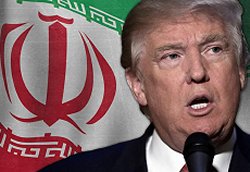
|
- Iran: Eight Prisoners Hanged on Drug Charges
- Daughter of late Iranian president jailed for ‘spreading lies’ - IRAN: Annual report on the death penalty 2016 - Taheri Facing the Death Penalty Again - Dedicated team seeking return of missing agent in Iran - Iran Arrests 2, Seizes Bibles During Catholic Crackdown
- Trump to welcome Netanyahu as Palestinians fear U.S. shift
- Details of Iran nuclear deal still secret as US-Tehran relations unravel - Will Trump's Next Iran Sanctions Target China's Banks? - Don’t ‘tear up’ the Iran deal. Let it fail on its own. - Iran Has Changed, But For The Worse - Iran nuclear deal ‘on life support,’ Priebus says
- Female Activist Criticizes Rouhani’s Failure to Protect Citizens
- Iran’s 1st female bodybuilder tells her story - Iranian lady becomes a Dollar Millionaire on Valentine’s Day - Two women arrested after being filmed riding motorbike in Iran - 43,000 Cases of Child Marriage in Iran - Woman Investigating Clinton Foundation Child Trafficking KILLED!
- Senior Senators, ex-US officials urge firm policy on Iran
- In backing Syria's Assad, Russia looks to outdo Iran - Six out of 10 People in France ‘Don’t Feel Safe Anywhere’ - The liberal narrative is in denial about Iran - Netanyahu urges Putin to block Iranian power corridor - Iran Poses ‘Greatest Long Term Threat’ To Mid-East Security |
Saturday 24 September 2011Performing art in Tehran
A stone’s throw from Tehran’s notorious Evin prison, three young people sit in an austere room, examining folders that turn out to hold their personal case files. Behind a desk in the corner of the room, an expressionless man slowly takes notes and leafs through the cases. Though this may seem like a nightmarish realization of Franz Kafka’s “The Trial” – a copy of which is symbolically placed on the examiner’s table – this scene takes place in an art gallery. As part of a popular exhibition visited by up to 1,000 spectators daily, it aims to introduce performance art here. Curator Amir Rad invited 30 local artists to conceptualize experimental performances of their own choosing. Some strove to rouse spectators to the authoritarian realities of their everyday lives. Others criticized tangible problems, such as air pollution. Still others targeted various social clichés. “I wanted to ... find new ways of expression,” says Mr. Rad. Doing so may introduce a new avenue for independent artists who are constantly searching to circumvent the restrictions of the Islamic Republic’s notoriously rigid cultural environment. “The relationship between artists and the government is like Tom and Jerry,” says cocurator Mohammad Rezaeerad. “Tom is always chasing Jerry, but Jerry always finds a way to outsmart him.” Source: The Christian Science Monitor |






